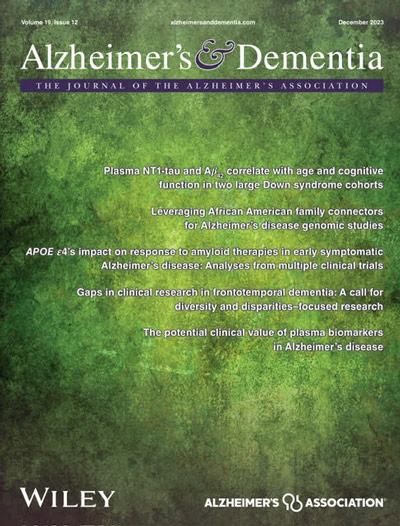Comprehensive characterization of the RNA editing landscape in the human aging brains with Alzheimer's disease
Abstract
INTRODUCTION
While RNA editing has been linked to Alzheimer's disease (AD), its specific impact on the transcriptomic landscape in human AD brains remains under explored.
METHODS
We conducted a comprehensive analysis of RNA editing across nine human brain regions affected by AD, utilizing RNA-seq data and matched whole-genome sequencing data from three human brain biobanks, adjusting for age, post mortem interval, sex, and apolipoprotein E4 (APOE4) status.
RESULTS
RNA-editing events were identified in both AD and healthy control aging brains, highlighting 127 genes with significant RNA editing loci. AD exhibited elevated RNA editing in the parahippocampal gyrus and cerebellar cortex. We also discovered 147 colocalized genome-wide association studies (GWAS) and cis-edQTL (± 1 MB) signals in 48 likely causal genes encompassing CLU, BIN1, and GRIN3B, primarily allied to amyloid and tau pathology, and neuroinflammation.
DISCUSSION
Our findings delineate RNA editing regulatory signatures in human AD, providing novel insights into AD pathophysiology and potential biomarkers and therapeutic targets.
Highlights
- · We discovered genome-wide landscape of RNA editing signals from 4208 (1364 Alzheimer's disease [AD] cases vs. 742 healthy controls) RNA-seq data across nine human brain regions from three large brain biobanks (Mount Sinai Brain Bank [MSBB], Mayo Clinic [MAYO] Religious Order Study and Memory and Aging Project [ROSMAP]) tied with AD, including in sex-specific and apolipoprotein E4 (APOE4) -specific manner adjusting for age, post mortem interval (PMI), sex, and APOE4 status.
- · We emphasize 127 genes, including SYT11, KCNIP4, NRG3, ANKS1B, and RALYL, exhibiting significant RNA editing loci shared by multiple brain tissues, mainly implicated in synaptic plasticity, signaling and transmission, neuronal development, and morphogenesis.
- · Brain-wide tissue-specific cis-regulatory variants (cis-edQTLs) were inspected using matched genotyping data from 3627 samples from all brain biobanks. We revealed 147 colocalized AD-GWAS and cis-edQTLs signals pertaining to 48 likely causal genes comprising CLU (rs7982, rs1532278), BIN1 (rs2276582, rs3768863), GRIN3B (rs10417824, rs1058603), NYAP1 (rs12539172), DGKQ (rs4690197, rs3733347), CLPTM1 (rs204468), etc.
- · Colocalized signals show affiliations to tau protein binding, amyloid-β regulation, cellular morphogenesis, and immune response pathway suggesting possible roles of epitranscriptomic mechanisms in shaping the AD risk.


 求助内容:
求助内容: 应助结果提醒方式:
应助结果提醒方式:


